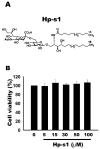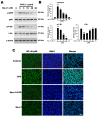Hp-s1 Ganglioside Suppresses Proinflammatory Responses by Inhibiting MyD88-Dependent NF-κB and JNK/p38 MAPK Pathways in Lipopolysaccharide-Stimulated Microglial Cells
- PMID: 33003399
- PMCID: PMC7600735
- DOI: 10.3390/md18100496
Hp-s1 Ganglioside Suppresses Proinflammatory Responses by Inhibiting MyD88-Dependent NF-κB and JNK/p38 MAPK Pathways in Lipopolysaccharide-Stimulated Microglial Cells
Abstract
Hp-s1 ganglioside is isolated from the sperm of sea urchin (Hemicentrotus pulcherrimus). In addition to neuritogenic activity, the biological function of Hp-s1 in neuroinflammation is unknown. In this study, we investigated the anti-neuroinflammatory effect of Hp-s1 on lipopolysaccharide (LPS)-stimulated microglial cells. MG6 microglial cells were stimulated with LPS in the presence or absence of different Hp-s1 concentrations. The anti-inflammatory effect and underlying mechanism of Hp-s1 in LPS-activated microglia cells were assessed through a Cell Counting kit-8 assay, Western blot analysis, and immunofluorescence. We found that Hp-s1 suppressed not only the expression of inducible nitric oxide synthase and cyclooxygenase-2 but also the expression of proinflammatory cytokines, such as TNF-α, IL-1β, and IL-6. Hp-s1 inhibited the LPS-induced NF-κB signaling pathway by attenuating the phosphorylation and translocation of NF-κB p65 and by disrupting the degradation and phosphorylation of inhibitor κB-α (IκBα). Moreover, Hp-s1 inhibited the LPS-induced phosphorylation of p38 mitogen-activated protein kinase (MAPK) and c-Jun N-terminal kinase (JNK). Hp-s1 also reduced the expression of myeloid differentiation factor 88 (MyD88) and TNF receptor-associated factors 6 (TRAF6), which are prerequisites for NF-κB and MAPKs activation. These findings indicated that Hp-s1 alleviated LPS-induced proinflammatory responses in microglial cells by downregulating MyD88-mediated NF-κB and JNK/p38 MAPK signaling pathways, suggesting further evaluation as a new anti-neuroinflammatory drug.
Keywords: ganglioside Hp-s1; lipopolysaccharide; microglia; neuroinflammation.
Conflict of interest statement
The authors declare no conflict of interest.
Figures







Similar articles
-
Phosphatidylcholine suppresses inflammatory responses in LPS-stimulated MG6 microglial cells by inhibiting NF-κB/JNK/p38 MAPK signaling.PLoS One. 2025 Jul 28;20(7):e0328206. doi: 10.1371/journal.pone.0328206. eCollection 2025. PLoS One. 2025. PMID: 40720378 Free PMC article.
-
Steppogenin Isolated from Cudrania tricuspidata Shows Antineuroinflammatory Effects via NF-κB and MAPK Pathways in LPS-Stimulated BV2 and Primary Rat Microglial Cells.Molecules. 2017 Dec 2;22(12):2130. doi: 10.3390/molecules22122130. Molecules. 2017. PMID: 29207498 Free PMC article.
-
Gastrodin inhibits expression of inducible NO synthase, cyclooxygenase-2 and proinflammatory cytokines in cultured LPS-stimulated microglia via MAPK pathways.PLoS One. 2011;6(7):e21891. doi: 10.1371/journal.pone.0021891. Epub 2011 Jul 12. PLoS One. 2011. PMID: 21765922 Free PMC article.
-
Vibrio harveyi infections induce production of proinflammatory cytokines in murine peritoneal macrophages via activation of p38 MAPK and NF-κB pathways, but reversed by PI3K/AKT pathways.Dev Comp Immunol. 2022 Feb;127:104292. doi: 10.1016/j.dci.2021.104292. Epub 2021 Oct 14. Dev Comp Immunol. 2022. PMID: 34656643 Review.
-
Exploring the Role of Licorice and Its Derivatives in Cell Signaling Pathway NF-κB and MAPK.J Nutr Metab. 2024 Oct 23;2024:9988167. doi: 10.1155/2024/9988167. eCollection 2024. J Nutr Metab. 2024. PMID: 39479405 Free PMC article. Review.
Cited by
-
Marine Microorganism Molecules as Potential Anti-Inflammatory Therapeutics.Mar Drugs. 2024 Sep 3;22(9):405. doi: 10.3390/md22090405. Mar Drugs. 2024. PMID: 39330286 Free PMC article. Review.
-
Alleviation of acute pancreatitis-associated lung injury by inhibiting the p38 mitogen-activated protein kinase pathway in pulmonary microvascular endothelial cells.World J Gastroenterol. 2021 May 14;27(18):2141-2159. doi: 10.3748/wjg.v27.i18.2141. World J Gastroenterol. 2021. PMID: 34025070 Free PMC article.
-
Terpenoids from Abies holophylla Attenuate LPS-Induced Neuroinflammation in Microglial Cells by Suppressing the JNK-Related Signaling Pathway.Int J Mol Sci. 2021 Jan 19;22(2):965. doi: 10.3390/ijms22020965. Int J Mol Sci. 2021. PMID: 33478055 Free PMC article.
-
Liver X Receptor Activation Attenuates Oxysterol-Induced Inflammatory Responses in Fetoplacental Endothelial Cells.Cells. 2023 Apr 19;12(8):1186. doi: 10.3390/cells12081186. Cells. 2023. PMID: 37190095 Free PMC article.
-
Naringin inhibits P2X4 receptor expression on satellite glial cells in the neonatal rat dorsal root ganglion.J Appl Biomed. 2023 Dec;21(4):193-199. doi: 10.32725/jab.2023.021. Epub 2023 Dec 4. J Appl Biomed. 2023. PMID: 38112458
References
MeSH terms
Substances
Grants and funding
LinkOut - more resources
Full Text Sources
Research Materials
Miscellaneous

